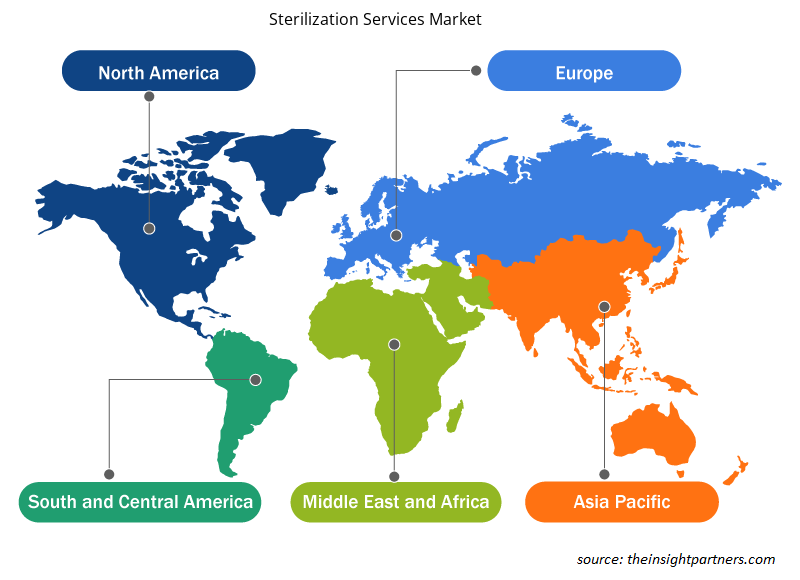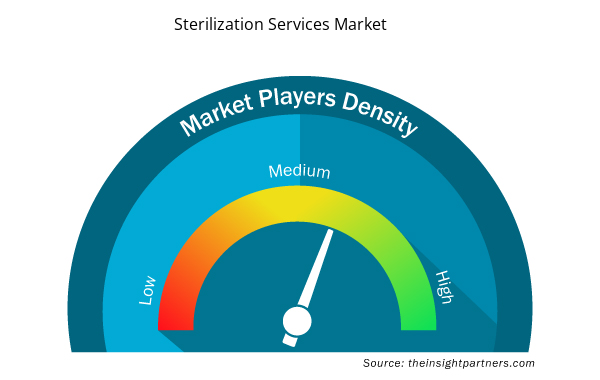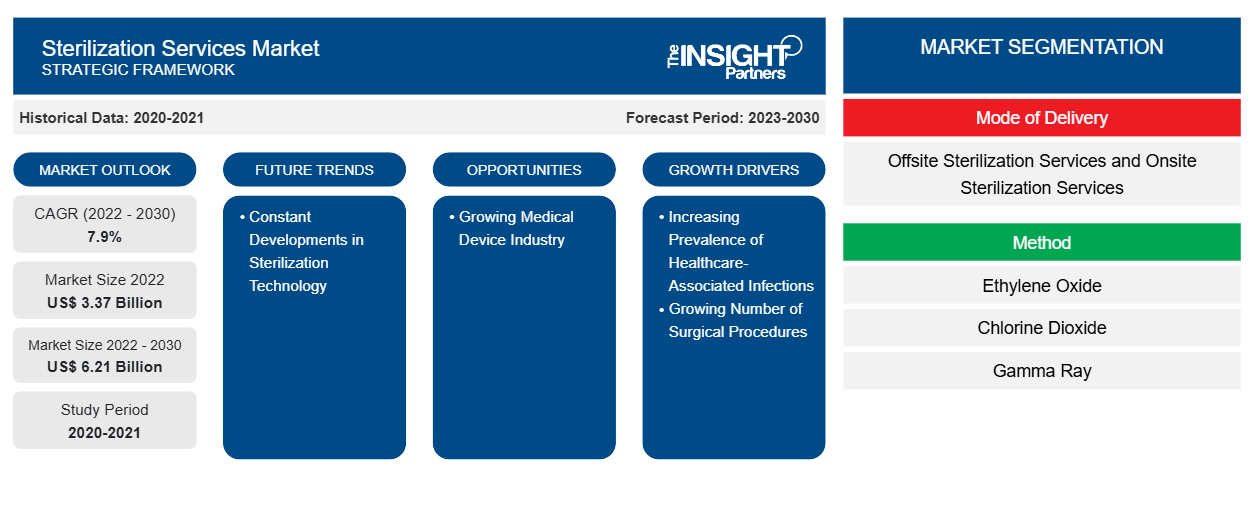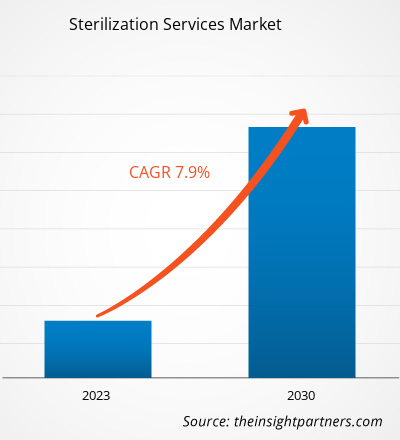[研究报告] 灭菌服务市场预计将从 2022 年的 33.6788 亿美元增至 2030 年的 62.1013 亿美元。预计 2022 年至 2030 年期间市场复合年增长率为 7.9%。
市场洞察和分析师观点:
医疗器械的灭菌方式多种多样,包括干热灭菌、湿热灭菌(蒸汽灭菌)、汽化过氧化氢灭菌、辐射灭菌、环氧乙烷灭菌以及其他灭菌方法,如汽化过氧乙酸灭菌、二氧化氯灭菌和二氧化氮灭菌。某些产品的灭菌过程精细而复杂,需要更高的质量标准。由于医院内感染和其他感染的增加、外科手术数量的增加、对消毒的更多关注以及制药和生物技术行业的增长,对医疗器械灭菌过程的需求不断增长。医疗相关感染的日益流行和外科手术数量的增加推动了灭菌服务市场的增长。
定制此报告以满足您的需求
您可以免费定制任何报告,包括本报告的部分内容、国家级分析、Excel 数据包,以及为初创企业和大学提供优惠和折扣
- 获取此报告的关键市场趋势。这个免费样品将包括数据分析,从市场趋势到估计和预测。
增长动力:
全球有数百万人在接受医疗治疗时感染了医院相关感染 (HAI)。卫生环境条件不佳、基础设施差、设备不足、缺乏指导方针以及缺乏感染控制措施知识等因素增加了 HAI 的患病率。根据美国疾病控制与预防中心 (CDC) 发布的《2021 年国家和州 HAI 进展报告》,2020-2021 年,一些医疗机构的 HAI 病例显著增加。 2020年至2021年急症护理医院标准化感染率的变化包括耐甲氧西林金黄色葡萄球菌菌血症增加14%,呼吸机相关事件增加12%,子宫切除术后手术部位感染(SSI)增加11%,中心静脉导管相关血流感染增加7%,导管相关尿路感染增加5%,艰难梭菌感染减少3%。根据NCBI 2022年发表的一篇文章,发展中国家的医院感染总体患病率已高达15.5%。此外,在危重患者中,医院感染的患病率据报道高达34.1%。
因消毒程序不当而导致的常见 HAI 包括乙肝和丙肝、SSI、HIV 感染、尿路和血管导管相关感染以及呼吸机相关感染。HAI 会给患者带来更多痛苦,增加住院时间和治疗费用,并产生对抗菌药物的耐药性。根据 MDPI 的数据,在美国,HAI 每年花费近 100-330 亿美元,而在欧洲,HAI 每年花费超过 82 亿美元(70 亿欧元)。
根据世界卫生组织的说法,医院感染的一些重要方面如下:
- 预计每 100 名住院患者中,发达国家有 7 名、发展中国家有 10 名将至少感染一次医院内感染。
- 泌尿道感染是高收入国家中最常见的医院内感染。
- 在低收入和中等收入国家,ICU 获得性感染发生率比高收入国家高出约 2-3 倍。在高收入国家,ICU 获得性感染影响到至少一次 HAI 患者的约 30%。
- 在发展中国家,新生儿感染医院内感染的可能性比发达国家高出 20 倍。
上述事实凸显了消毒在医疗保健中预防 HAI 的重要性。手术器械和可重复使用物品(如内窥镜设备、呼吸护理设备和血液透析设备)消毒不足会导致 HAI。由于流行病的广泛传播和人们对抗菌素耐药性的认识不断提高,一些国家开始关注维护无菌环境,并投入资源加强消毒服务。因此,所有这些因素共同推动了全球范围内消毒服务的采用。
报告细分和范围:
“全球灭菌服务市场”根据交付方式、方法、服务类型和最终用户进行细分。根据交付方式,市场分为异地灭菌服务和现场灭菌服务。就方法而言,灭菌服务市场分为环氧乙烷、二氧化氯、伽马射线、电子束、高压灭菌蒸汽等。根据服务类型,市场分为合同灭菌和微生物灭菌服务、测试和验证服务、设备等。根据最终用户,灭菌服务市场分为医疗器械公司、制药和生物制药公司、医院和诊所等。根据地理位置,灭菌服务市场分为北美(美国、加拿大和墨西哥)、欧洲(德国、法国、意大利、英国、俄罗斯和欧洲其他地区)、亚太地区(澳大利亚、中国、日本、印度、韩国和亚太地区其他地区)、中东和非洲(南非、沙特阿拉伯、阿联酋和中东和非洲其他地区)以及南美洲和中美洲(巴西、阿根廷和南美洲和中美洲其他地区)
节段分析:
根据交付方式,灭菌服务市场分为异地灭菌服务和现场灭菌服务。异地灭菌部分在 2022 年占据了更大的市场份额。此外,预计现场灭菌部分在预测期内的复合年增长率将更高。由于服务提供商数量的增加和外包灭菌服务的上升趋势,许多医院选择异地灭菌服务。异地灭菌服务已被证明对医院具有成本效益。此外,该行业的公司任命具有出色技术知识的合格员工来提供更好的服务,同时通过遵守政府法规保持高标准。他们还提出了创新的解决方案来减少客户的时间和成本,从而引发了对异地灭菌服务的需求。例如,STERIS plc 的移动无菌处理单元是一个完全集成的移动中央无菌处理部门 (SPD),它允许采用交钥匙流程来持续支持医院建设、翻新或扩建期间的运营而不中断。
根据方法,灭菌服务市场细分为环氧乙烷、二氧化氯、伽马射线、电子束、高压灭菌蒸汽等。环氧乙烷部分在 2022 年占据最大市场份额。二氧化氯部分预计在预测期内的复合年增长率最高,为 8.8%。根据先进医疗服务类型协会 (AdvaMed) 的数据,环氧乙烷每年用于美国约 200 亿台医疗设备的灭菌。广泛的材料兼容性、易渗透性和相当大的灭菌能力是促进灭菌服务市场增长的主要优势之一。全球有广泛的环氧乙烷灭菌服务提供商网络。STERIS 是感染预防和其他程序产品和服务的著名提供商之一,在全球拥有 50 多个合同灭菌和实验室设施网络。
根据服务类型,灭菌服务市场细分为合同灭菌和微生物减少服务、测试和验证服务、设备等。合同灭菌和微生物减少服务部分在 2022 年占据了最大的市场份额,预计在预测期内将实现最高的复合年增长率。医疗器械制造业正面临日益激烈的竞争,对灭菌服务提供商的定制服务的需求也日益增加。合同灭菌服务人员经过培训,熟悉行业标准。在过去几年中,合同灭菌行业由于成本效益高以及这些服务在大型和小型制造商中得到广泛采用而实现了惊人的增长。此外,完善的网络使合同服务提供商能够向广大客户提供不同的服务,从而扩大其市场覆盖范围。
根据最终用户,灭菌服务市场细分为医疗器械公司、制药和生物制药公司、医院和诊所等。医疗器械公司部门在 2022 年占据了最大的市场份额,预计同一部门在预测期内的复合年增长率最高。由于医疗器械制造和包装方面的严格法规和合规要求,医疗器械制造商是灭菌服务的主要最终用户之一。这些产品必须是无菌的,以避免使用这些设备的人之间发生感染。
区域分析:
根据地理位置,绝育服务市场分为五个主要区域:北美、欧洲、亚太地区、南美和中美以及中东和非洲。对北美市场的分析主要集中在三个主要国家——美国、加拿大和墨西哥。预计在预测期内,美国将占据最大的绝育服务市场份额。由于绝育服务的便捷性和美国外科手术的增加,绝育服务市场预计将增长。根据美国整形外科医师协会 (ASPS) 的数据,2020 年,美国进行了 1560 万例整容手术 和 1320 万例微创整容手术,比 2019 年增长 3%。2020 年,美国排名前五的整容手术是隆胸、抽脂、鼻部整形、眼睑手术和面部拉皮术。此外,2020 年进行了 193,073 例隆胸手术。因此,随着外科手术的激增,对设施和设备消毒的需求也随之增加。
灭菌服务市场机会:
由于技术的不断进步,医疗器械行业预计将经历显着增长。对更好医疗设施的不断增长的需求促使发展中经济体专注于技术支持的医疗保健解决方案。老年人口、慢性病病例和儿科护理的增加也增加了对先进医疗设施的需求。此外,顶级创收医疗器械公司正在大力投资先进技术和灭菌服务的研发。
医疗设备和设备是用于监测患者的重要工具。灭菌是医疗设备制造过程中的关键步骤之一。灭菌方式因材料兼容性、工艺可用性、加工位置、物理设备属性、监管批准、成本和各国监管注册而异。医疗设备的灭菌在制造和使用过程中都至关重要。不适当的设备消毒会导致健康风险,并难以从 FDA 等监管机构获得市场许可。此外,医疗保健组织需要妥善管理灭菌,以确保患者的安全。因此,不断发展的医疗器械行业预计将为灭菌服务市场的主要参与者提供丰厚的机会。
灭菌服务市场区域洞察
Insight Partners 的分析师已详尽解释了预测期内影响灭菌服务市场的区域趋势和因素。本节还讨论了北美、欧洲、亚太地区、中东和非洲以及南美和中美洲的灭菌服务市场细分和地理位置。

- 获取灭菌服务市场的区域特定数据
灭菌服务市场报告范围
| 报告属性 | 细节 |
|---|---|
| 2022 年市场规模 | 33.7亿美元 |
| 2030 年的市场规模 | 62.1亿美元 |
| 全球复合年增长率(2022 - 2030 年) | 7.9% |
| 史料 | 2020-2021 |
| 预测期 | 2023-2030 |
| 涵盖的领域 | 按交付方式
|
| 覆盖地区和国家 | 北美
|
| 市场领导者和主要公司简介 |
|
灭菌服务市场参与者密度:了解其对业务动态的影响
灭菌服务市场正在快速增长,这得益于终端用户需求的不断增长,而这些需求又源于消费者偏好的不断变化、技术进步以及对产品优势的认识不断提高等因素。随着需求的增加,企业正在扩大其产品范围,进行创新以满足消费者的需求,并利用新兴趋势,从而进一步推动市场增长。
市场参与者密度是指在特定市场或行业内运营的企业或公司的分布情况。它表明在给定市场空间中,相对于其规模或总市场价值,有多少竞争对手(市场参与者)存在。
在灭菌服务市场运营的主要公司有:
- BGS Beta-Gamma 服务有限公司
- 康美集团
- 电子束服务公司
- 生命科学外包公司
- 意大利梅迪斯特里公司
免责声明:上面列出的公司没有按照任何特定顺序排列。

- 获取灭菌服务市场顶级关键参与者概述
COVID-19 影响:
在 COVID-19 疫情爆发之前,灭菌服务市场一直在稳步增长,并受到塑造其动态的各种因素的影响。尽管如此,疫情对灭菌服务市场产生了积极影响。灭菌一直是直接对抗 SARS-CoV-2 和阻止 COVID-19 传播的重要工具,尤其是在医疗机构中。根据 2021 年 5 月发表在《环境科学与污染研究》上的一篇文章,消毒剂和消毒剂是针对 COVID-19 对表面和设备进行消毒的必要预防措施。由于疫情期间过滤式面罩呼吸器短缺,一些医疗机构不得不在使用各种净化技术(例如伽马射线照射 (GIR))后重新使用过滤式面罩呼吸器 (FFR)。
竞争格局和重点公司:
全球灭菌市场的一些知名参与者包括 Steris Plc、Sotera Health、Cretex Medical、Scapa Healthcare、BGS Beta-Gamma-Service GmbH & Co. KG、E-BEAM Services, Inc.、Medistri SA、Midwest Sterilization Corporation (MSC)、Microtrol Sterilisation Services、ClorDiSys Solutions Inc、Consolidated Sterilizer Systems 和 Boulder Sterilization。这些公司专注于新技术、现有产品的进步和地域扩张,以满足全球不断增长的消费者需求并增加其专业产品组合的产品范围。例如,2023 年 5 月,Boulder Sterilization 推出了合同二氧化氯 (CD) 灭菌服务。随着这项服务组合的增加,Boulder Sterilization 成为全球唯一一家为医疗器械和体外诊断产品提供 CD 和环氧乙烷技术的合同灭菌商。
- 历史分析(2 年)、基准年、预测(7 年)及复合年增长率
- PEST 和 SWOT 分析
- 市场规模价值/数量 - 全球、区域、国家
- 行业和竞争格局
- Excel 数据集



Report Coverage
Revenue forecast, Company Analysis, Industry landscape, Growth factors, and Trends

Segment Covered
This text is related
to segments covered.

Regional Scope
North America, Europe, Asia Pacific, Middle East & Africa, South & Central America

Country Scope
This text is related
to country scope.
常见问题
Sterilization is a process that helps in the elimination, removal, or deactivation of all life forms other biological agents that may be present in food, the surface of an article or in a fluid, etc. Sterilization is performed through various methods such as heat, chemicals, irradiation, high pressure, and filtration. Usually, a third party provides contract-based sterilization service to multiple industries such as hospitals, food, and beverage industry pharmaceutical companies, consumer, and industrial communities.
The Sterilization services market majorly consists of the players such as BGS Beta-Gamma-Service GmbH & Co. KG, Cosmed Group, E-BEAM Services Inc, Life Science Outsourcing Inc., MEDISTRI SA, Midwest Sterilization Corporation, Sotera Health Company, Microtrol Sterilisation Services Pvt Ltd., STERIS plc., Scapa and among others.
The market players are involved in acquisitions, strategic collaborations, and new product launches to withstand the competition. For instance, in June 2021, Steris Plc. acquired Cantel Medical, a global provider of infection prevention products and services to endoscopy, dental, dialysis and life sciences customers. The acquisition will leverage the expertise of the company to provide a more extensive and innovative suite of product offerings to the customers around the world.
The factors that are driving growth of the market are increasing prevalence of healthcare associated infections and increasing number of surgical procedures worldwide are expected to boost the growth of the global Sterilization services market.
North America dominated the sterilization services market with a share of more than 30% in 2020. This is attributable to increasing prevalence of healthcare-associated infections, and a rising number of surgical procedures.
The factor that is restraining the adoption of Sterilization services are Stringent Regulation Regarding Chemical Emission.
Trends and growth analysis reports related to Life Sciences : READ MORE..
The List of Companies - Sterilization Services Market
- BGS Beta-Gamma-Service GmbH & Co. KG
- Cosmed Group
- E-Beam Services Inc.
- Life Science Outsourcing Inc.
- Medistri SA
- Midwest Sterilization Corporation
- Sotera Health Company
- Microtrol Sterilisation Services Pvt Ltd
- Steris Plc
- Cretex Medical
The Insight Partners performs research in 4 major stages: Data Collection & Secondary Research, Primary Research, Data Analysis and Data Triangulation & Final Review.
- Data Collection and Secondary Research:
As a market research and consulting firm operating from a decade, we have published and advised several client across the globe. First step for any study will start with an assessment of currently available data and insights from existing reports. Further, historical and current market information is collected from Investor Presentations, Annual Reports, SEC Filings, etc., and other information related to company’s performance and market positioning are gathered from Paid Databases (Factiva, Hoovers, and Reuters) and various other publications available in public domain.
Several associations trade associates, technical forums, institutes, societies and organization are accessed to gain technical as well as market related insights through their publications such as research papers, blogs and press releases related to the studies are referred to get cues about the market. Further, white papers, journals, magazines, and other news articles published in last 3 years are scrutinized and analyzed to understand the current market trends.
- Primary Research:
The primarily interview analysis comprise of data obtained from industry participants interview and answers to survey questions gathered by in-house primary team.
For primary research, interviews are conducted with industry experts/CEOs/Marketing Managers/VPs/Subject Matter Experts from both demand and supply side to get a 360-degree view of the market. The primary team conducts several interviews based on the complexity of the markets to understand the various market trends and dynamics which makes research more credible and precise.
A typical research interview fulfils the following functions:
- Provides first-hand information on the market size, market trends, growth trends, competitive landscape, and outlook
- Validates and strengthens in-house secondary research findings
- Develops the analysis team’s expertise and market understanding
Primary research involves email interactions and telephone interviews for each market, category, segment, and sub-segment across geographies. The participants who typically take part in such a process include, but are not limited to:
- Industry participants: VPs, business development managers, market intelligence managers and national sales managers
- Outside experts: Valuation experts, research analysts and key opinion leaders specializing in the electronics and semiconductor industry.
Below is the breakup of our primary respondents by company, designation, and region:

Once we receive the confirmation from primary research sources or primary respondents, we finalize the base year market estimation and forecast the data as per the macroeconomic and microeconomic factors assessed during data collection.
- Data Analysis:
Once data is validated through both secondary as well as primary respondents, we finalize the market estimations by hypothesis formulation and factor analysis at regional and country level.
- Macro-Economic Factor Analysis:
We analyse macroeconomic indicators such the gross domestic product (GDP), increase in the demand for goods and services across industries, technological advancement, regional economic growth, governmental policies, the influence of COVID-19, PEST analysis, and other aspects. This analysis aids in setting benchmarks for various nations/regions and approximating market splits. Additionally, the general trend of the aforementioned components aid in determining the market's development possibilities.
- Country Level Data:
Various factors that are especially aligned to the country are taken into account to determine the market size for a certain area and country, including the presence of vendors, such as headquarters and offices, the country's GDP, demand patterns, and industry growth. To comprehend the market dynamics for the nation, a number of growth variables, inhibitors, application areas, and current market trends are researched. The aforementioned elements aid in determining the country's overall market's growth potential.
- Company Profile:
The “Table of Contents” is formulated by listing and analyzing more than 25 - 30 companies operating in the market ecosystem across geographies. However, we profile only 10 companies as a standard practice in our syndicate reports. These 10 companies comprise leading, emerging, and regional players. Nonetheless, our analysis is not restricted to the 10 listed companies, we also analyze other companies present in the market to develop a holistic view and understand the prevailing trends. The “Company Profiles” section in the report covers key facts, business description, products & services, financial information, SWOT analysis, and key developments. The financial information presented is extracted from the annual reports and official documents of the publicly listed companies. Upon collecting the information for the sections of respective companies, we verify them via various primary sources and then compile the data in respective company profiles. The company level information helps us in deriving the base number as well as in forecasting the market size.
- Developing Base Number:
Aggregation of sales statistics (2020-2022) and macro-economic factor, and other secondary and primary research insights are utilized to arrive at base number and related market shares for 2022. The data gaps are identified in this step and relevant market data is analyzed, collected from paid primary interviews or databases. On finalizing the base year market size, forecasts are developed on the basis of macro-economic, industry and market growth factors and company level analysis.
- Data Triangulation and Final Review:
The market findings and base year market size calculations are validated from supply as well as demand side. Demand side validations are based on macro-economic factor analysis and benchmarks for respective regions and countries. In case of supply side validations, revenues of major companies are estimated (in case not available) based on industry benchmark, approximate number of employees, product portfolio, and primary interviews revenues are gathered. Further revenue from target product/service segment is assessed to avoid overshooting of market statistics. In case of heavy deviations between supply and demand side values, all thes steps are repeated to achieve synchronization.
We follow an iterative model, wherein we share our research findings with Subject Matter Experts (SME’s) and Key Opinion Leaders (KOLs) until consensus view of the market is not formulated – this model negates any drastic deviation in the opinions of experts. Only validated and universally acceptable research findings are quoted in our reports.
We have important check points that we use to validate our research findings – which we call – data triangulation, where we validate the information, we generate from secondary sources with primary interviews and then we re-validate with our internal data bases and Subject matter experts. This comprehensive model enables us to deliver high quality, reliable data in shortest possible time.


 获取此报告的免费样本
获取此报告的免费样本